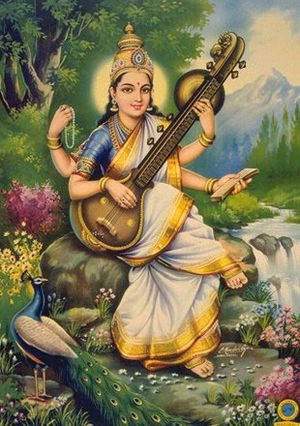Сарасвати


Божественная Мать в лице Сарасвати является шакти Брахмы. В индуистской Троице Брахма известен как Творец, что соответствует ипостаси Бога-Отца в западной Троице. Он — Божественный Законодатель, источник всего знания. Вместе Брахма и Сарасвати являются воплощением космической силы.
Attributes
Сарасвати известна как Богиня Речи. Ее отождествляют с Вач, Словом. Она олицетворяет красноречие и наставляет в мудрости Закона. Сарасвати является Матерью-Учителем для тех из нас, кто любит Закон, который поверяет нам Брахма; она — сила желания, воли и мотивации быть Законом в действии. Сарасвати представляет союз силы и ума, из которого возникает живое творение.
In the book Symbolism in Hinduism, A. Parthasarathy notes that the name Sarasvati literally means “the one who gives the essence of our own Self.” Сарасвати иногда изображают с четырьмя руками, сидящей на лотосе. В одной руке она держит тексты священных писаний, в другой — цветок лотоса. Другими двумя руками она играет на вине — индийской лютне.[1]
Parthasarathy writes: “The Goddess, therefore, represents the ideal guru.... ‘Sitting on the lotus’ symbolises that the teacher is well established in the subjective experience of the Truth. ‘Holding the Scriptures in her hand’ indicates that she upholds that the knowledge of the Scriptures alone can take us to the Truth." Parthasarathy says that Sarasvati’s playing of the lute suggests “that a truly qualified teacher tunes up the mind and intellect of the seeker and draws out of him the music and melody of life.”[2]
According to scholar David Frawley, in an esoteric sense Sarasvati “represents the stream of wisdom, the free flow of the knowledge of consciousness.”[3] She is called the Flowing One, the source of creation by the Word.
Сарасвати также олицетворяет чистоту и облачена в белые одежды. David Kinsley, Professor of Religious Studies at McMaster University in Ontario, Canada, explains:
The predominant themes in Sarasvati’s appearance are purity and transcendence. She is almost always said to be pure white like snow, the moon, or the kunda flower.... Her garments are said to be fiery in their purity....
Белый лебедь отображает трансцендентную природу Сарасвати и является символом духовного мастерства и совершенства в индуизме... Sarasvati, astride her swan, suggests a dimension of human existence that rises above the physical, natural world. Her realm is one of beauty, perfection, and grace; it is a realm created by artistic inspiration, philosophic insight, and accumulated knowledge, which have enabled human beings to so refine their natural world that they have been able to transcend its limitations. Sarasvati astride her swan beckons human beings to continued cultural creation and civilized perfection.... She not only underlies the world and is its creator but is the [very] means to transcend the world.[4]
Сарасвати ассоциируют с речью, поэзией, музыкой и культурой, она известна как Богиня Знания и Покровительница искусств и музыки. Ее почитают как в индуизме, так и в буддизме. Для буддистов она — супруга Манджушри, бодхисаттвы мудрости. Буддисты взывают к Манджушри, прося даровать понимание, мудрость, овладение учением, способность толковать священные тексты, красноречие и память. Он работает с Господом Майтрейей. Иногда Майтрейю и Манджушри изображают вместе с Гаутамой Буддой, где Манджушри представляет аспект мудрости, а Майтрейя – аспект сострадания буддистского учения. Подобно Сарасвати, Манджушри наделяет даром озарения.
Река Сарасвати
В древнейших индуистских текстах — «Ведах» Сарасвати предстает богиней реки. В «Ведах» сказано, что Сарасвати являлась крупнейшей рекой в Индии, и, хотя в течение многих лет ученые утверждали, что это — не более чем миф, археологические раскопки, проводившиеся в 1985 году, обнаружили древнее русло реки, которое соответствует описанию Сарасвати. Эта великая река, шириной от шести до десяти метров в большей части своей длины, брала начало в Гималайских горах, несла свои воды на запад и там впадала в море. Frawley believes that the Sarasvati was the main site of habitation at the time the Vedas were composed thousands of years ago.[5]
Frawley says that the Sarasvati, “like the later Ganges, symbolizes the Sushumna, the river of spiritual knowledge, the current that flows [through the spinal canal] through the seven chakras of the subtle body. She is not only the Milky Way or river of Heaven, inwardly she is the river of true consciousness that flows into this world.”[6]
Ригведы именуют Сарасвати «лучшей матерью, лучшей рекой и лучшей богиней».[7] It also says, “Sarasvati like a great ocean appears with her ray, she rules all inspirations.”[8]
Ее священный «корневой слог», или биджа, — Айм. Биджа-мантра заключает в себе сущность Космического Существа, принципа или чакры. Мантра Сарасвати — Ом Айм Сарасвати Намаха.
См. также
Sources
Mark L. Prophet and Elizabeth Clare Prophet, The Masters and Their Retreats, s.v. “Sarasvati, Shakti of Brahma.”
- ↑ A. Parthasarathy, “Consorts of the Three Gods,” in R. S. Nathan, comp., Symbolism in Hinduism (Bombay: Central Chinmaya Mission Trust, 1989), p. 157.
- ↑ Ibid., pp. 157–58.
- ↑ David Frawley, From the River of Heaven: Hindu and Vedic Knowledge for the Modern Age (Sandy, Utah: Morson Publishing, 1990), p. 126.
- ↑ David Kinsley, Hindu Goddesses: Visions of the Divine Feminine in the Hindu Religious Tradition (Berkeley, Calif.: University of California Press, 1986), pp. 62, 141.
- ↑ David Frawley, Gods, Sages and Kings: Vedic Secrets of Ancient Civilization (Salt Lake City, Utah: Passage Press, 1991), pp. 72–76, 354–57 nn. d–g.
- ↑ Ibid., p. 219.
- ↑ Rigveda 2.41.16, 1.3.12, quoted in Frawley, Gods, Sages and Kings, pp. 70, 71.
- ↑ Sri-sukta 1, 6, 13, 4, in Rigveda, cited by David Kinsley, The Goddesses’ Mirror: Visions of the Divine from East and West (Albany, N.Y.: State University of New York Press, 1989), p. 55.
